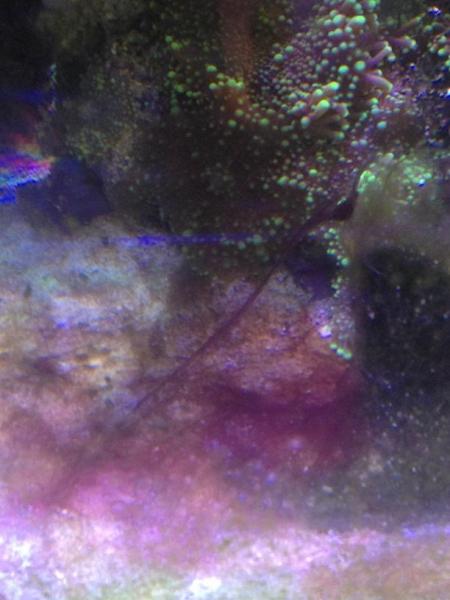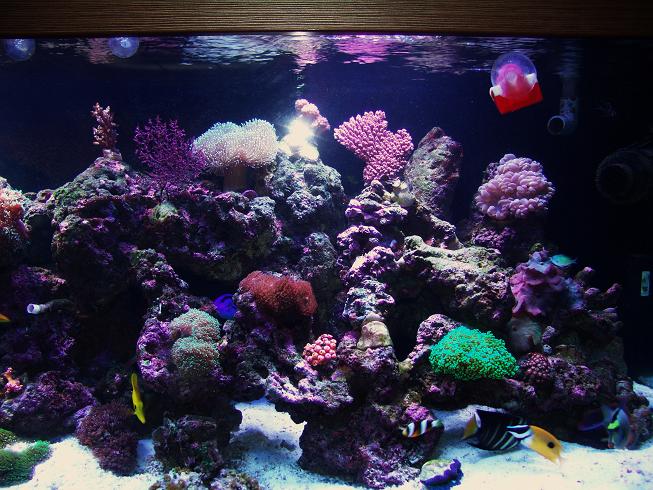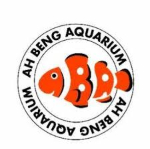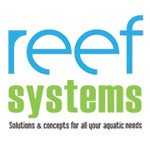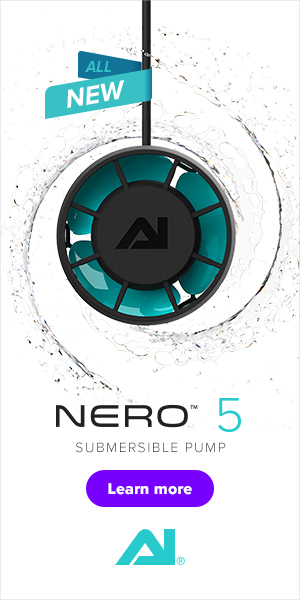Battling with nuisance Algae in our marine aquarium

Algae and “That Other Slimy Stuff”
There are many types of algae. There are also a few organisms that look like algae but not all are algae at all. In a healthy aquarium, the algae will be green, and if left alone, will grow hair-like in appearance. Algae that is red or brown may indicate a water quality problem, such as high dissolved nitrate or phosphate levels in the water. Red and brown algae are also common in new tanks when the aquarium is not yet ecologically balanced. These types of algae are also quite common in saltwater fish-only tanks when the coral decorations are cleaned on a regular basis. The small round green “dots” that form on the sides of a tank are not algae. These are actually populations of Diatoms, microscopic animals that secrete a hard calcium shell on which green algae grows. This type of “algae” is the most difficult to remove.
An aquarium may occasionally break out with an infestation of cyanobacteria, a slimy growth that grows more rapidly than algae. It may be green, blue, black or red in colour. Unlike algae, cyanobacteria is extremely easy to remove but very difficult to control. Even if every bit is removed, it can quickly grow back in only a few days.
Cyanobacteria thrive in well-lit aquariums that have excessive levels of phosphate in the water. Cyanobacteria can also plague marine aquariums in which the coral is cleaned frequently. In order to bring cyanobacteria under control, the aquarium must be cleaned thoroughly. The amount of light the tank receives is dramatically reduced for several weeks. An organic chemical such as Boyd’s Chemi Clean is also added to the water to inhibit the growth of cyanobacteria. Several treatments may be necessary before the problem is brought under control.
Although it’s rather unattractive, algae is not “dirt”, but a primitive form of plant-like life. Green and some brown algae growth is normal and natural and occurs in nearly all aquariums. Like plants, all species of algae need light, water and nutrients to grow. Since an aquarium provides the water, we’re left with two factors that you can control to prevent the rapid accumulation of algae.
These are: the amount of light the aquarium receives; and the levels of nutrients dissolved in the water. There are also tap water pretreatment, filtration and sterilization methods that can tremendously reduce the growth rate and accumulation of algae.
Lighting:
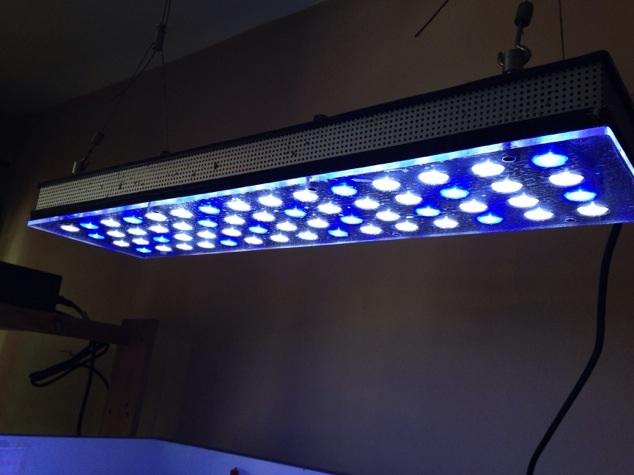
Limiting the light that the aquarium receives is the most important factor in controlling algae growth. If an aquarium is near a window, algae will grow faster, even if the aquarium does not receive direct sunlight. Leaving the aquarium lights on for more than eight hours a day can also cause rapid algae growth. We suggest that the aquarium be placed as far away from a window as possible. If an aquarium must be placed near or facing a window, blinds or drapery should be kept closed during the day. The aquarium lights should not be on for more than ten hours a day. Fish require no less than six hours of light every day in order to manufacture vitamin D. They also must have consistent lighting, with the lights coming on and going off at the same times every day.
We recommend that the tank lights be controlled by a timer. It is ok to adjust the aquarium lighting to coincide with your schedule, so you can enjoy the aquarium when you’re home, provided the lighting time period (photoperiod) is always consistent. If the light timer is set to come on in the afternoon, and go out late at night, the amount of ambient daylight the aquarium receives should be limited by closing blinds or drapes during the day. The light timer should be set to come on an hour before you get home and to go off an hour after you go to bed. The aquarium lights should never be set to come on and off more than once a day. Please remember that fish should be fed twice a day. Fish will not feed in a dark aquarium. If the lights are set for an afternoon/evening cycle, feed the fish once when you get home, and once again before you retire for the evening.
Nutrients:
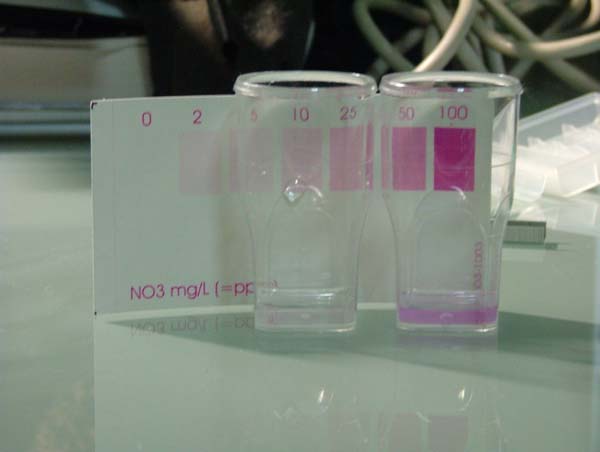
Like any plant, algae require food to survive. The three main nutrients that algae need are nitrogen, phosphorus and potassium. In an aquarium, these nutrients come from fish waste, uneaten food, the metabolism of beneficial bacteria, and the decay of other organics such as plant debris or even dead algae. There is also a surprisingly high amount of phosphorus in our tap water. You control the accumulation of nitrogen when you perform a water change. Phosphates may be controlled by using phosphate-removal media in an external filter or by using reverse osmosis water for the aquarium.

Cleaner Tanks Grow Algae Faster!
This is a difficult concept to understand. It is important to remember that algae growth is a natural, normal process in any aquarium. All aquariums grow algae in one form or another. Some algae grow naturally in all ponds, lakes, rivers and oceans. If a section of the ocean floor is swept completely clean of life by a hurricane, the first organism to start growing back is algae. When you clean your aquarium and all of the decorations thoroughly, you leave no algae behind. In this bright, squeaky-clean environment, algae grow back more rapidly than it would if you left a small number of algae somewhere in the tank. This is especially true in saltwater aquariums, where the bright white coral and gravel reflect more light, causing algae to grow faster.
The reason for this is that if there is no algae left in the tank, there is no competition for nutrients that the algae feed on. If you leave a few rocks or pieces of coral in a tank with a good growth of algae on them, that algae will consume nutrients in the water, which helps to control new growth.
The best way to illustrate this principle is to take a look at the two types of aquariums that are rarely plagued with heavy algae growth. These are freshwater aquariums that are well-populated with live plants; and saltwater live-coral reef aquariums.
In these aquariums, the plants in freshwater tanks, and the photosynthetic corals, anemones, and other sessile invertebrates in reef tanks, compete with algae for light and nutrients. As algae is a relatively primitive organism, it doesn’t stand a chance when competing against the more advanced plants or photosynthetic corals in these types of aquariums. It is actually better for your aquarium to allow some algae to exist somewhere in the tank, especially if your aquarium has chronic algae problems.
What About Algae-Eating Animals?
.png.02659b156bc93d413262e5a798297729.png)
There are very few fish available for marine aquariums that will eat the algae that grow in an aquarium. Certain tangs, parrotfish, and blennies will graze on some of the algae, but not effectively enough to keep the tank clean. There are quite a few marine invertebrates such as certain crabs, hermit crabs, snails and sea urchins that can eat a lot of algae. Unfortunately, few of these invertebrates can be kept safely in the average saltwater fish-only tank. These animals are the natural prey of much desirable saltwater fish, and your fish would willingly eat many of these expensive “snacks” if given the opportunity. These invertebrates can be kept in a marine living-coral reef aquarium, where the fish are smaller omnivorous species that will leave them alone.
Our Wonderful Tap water (or Things You Don’t Want to Know)
Almost all municipal water treatment facilities treat our tap water to kill algae, bacteria and protozoa before it is filtered and delivered to our faucets. Not all of the chemicals that are used get filtered out. On any given day, our tap water may contain fluoride, iodine, chlorine, chloramine, and traces of: potassium permanganate, magnesium sulfate, nickel sulfate, copper sulfate, various heavy metal-nitrate complexes, as well as pollutants such as lead, PCB, mercury, and silver nitrate. Yummy! More of these chemicals are used during the fall and spring when temperature changes cause a phenomenon called “Biannual Turnover”. Temperature fluctuations cause the water at the bottom of lakes to rise, carrying silt and anaerobic material up into the water collected for our use. All of the chemicals used in tap water can be toxic to fish.
Although a good portion of our municipal plumbing systems has been modernized, nearly all of them still have old lead pipes in-line which can create deadly high-lead levels in our drinking water. The cost of replacing these pipes is astronomical, so another solution was found. Several years ago, water treatment plants started introducing a phosphorus compound into our tap water which binds to the lead in the pipes and coats them so that lead does not get into our water. Unfortunately, this has had the bad side-effect of creating rather high levels of phosphates in tap water. We have tested levels of over 0.50 parts per million in our tap water. Our test kits only measure up to 0.10 ppm, and we have had to dilute our samples by as much as ten times to achieve accurate readings! This high level of phosphates in the tap water has been a major cause of rapid algae growth in aquaria for the last few years. We lower these levels considerably by using phosphate-removal filter media in your external filter. However, every time you change the water, you actually add more phosphates to the aquarium. If the city uses more phosphorus from time to time, the algae can grow back almost immediately after your aquarium is cleaned.
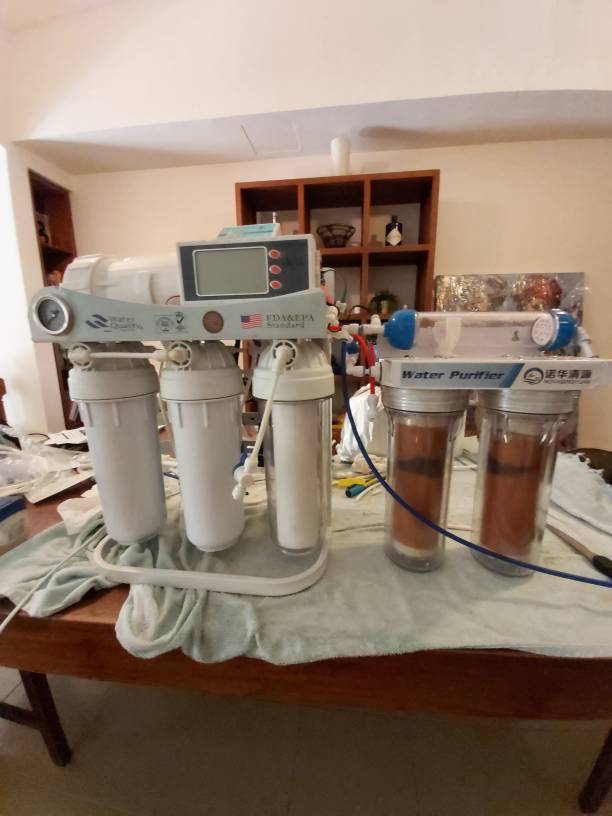
It is strongly recommended to use a RO/DI water filter set to achieve a 100% pure water to prevent any introduction of an unwanted chemical into your system.
Special Equipment to Control/Prevent Algae Growth
The Aquarium Professionals Group has installed many state-of-the-art aquarium systems which use various devices designed to prevent the growth of algae. Some of this equipment is impractical or too expensive for the average aquarium owner. The various equipment and/or techniques that can be used are:
1) Ultraviolet Sterilizers;
2) Ozonization;
3) Reverse Osmosis;
4) Resin Exchange Filters;
5) Algae Scrubbers; and
6) Using Reverse Osmosis, Bottled or Distilled Water for Water Changes.
We discuss all of the above filtration and water-treatment techniques in our newly-expanded filtration section. The use of reverse osmosis water for the aquarium will prevent any excess phosphates or other chemicals from getting in the aquarium, thereby helping to control algae.
What You Can Do to Help Prevent Algae Growth
It is normal for algae to begin growing back in an aquarium within three weeks after the tank is cleaned. Please keep in mind that light and nutrients in the water are the major causes of algae growth. There are several ways that you can help control the re-growth of algae in your aquarium:
Don’t overfeed your aquarium. Follow our recommendations in the article on feeding.
If a fish dies, remove it immediately. Decaying matter creates high levels of nutrients in the water, causing rapid algae growth.
Keep one or several pieces of rock or coral in your marine fish-only tank that is never cleaned. Allowing a controlled amount of algae to exist in the tank will provide competition for new algae growth.
If you use decorative coral, bleach the coral in your marine fish-only tank every other month instead of every month. This works on the same principle as leaving some algae in the tank.
If you do not already have an external canister filter on your aquarium, install one. By using large quantities of chemical removal material in these filters, you can help prevent algae growth. Protein skimmers in marine tanks also help to reduce algae growth in the aquarium.
Unless your aquarium already has one, install an ultraviolet sterilizer on the tank. Besides controlling parasites in the water, these devices also kill algae cells in the water before they can grow in your tank
References ;
http://www.aquariump…les/algae.shtml
